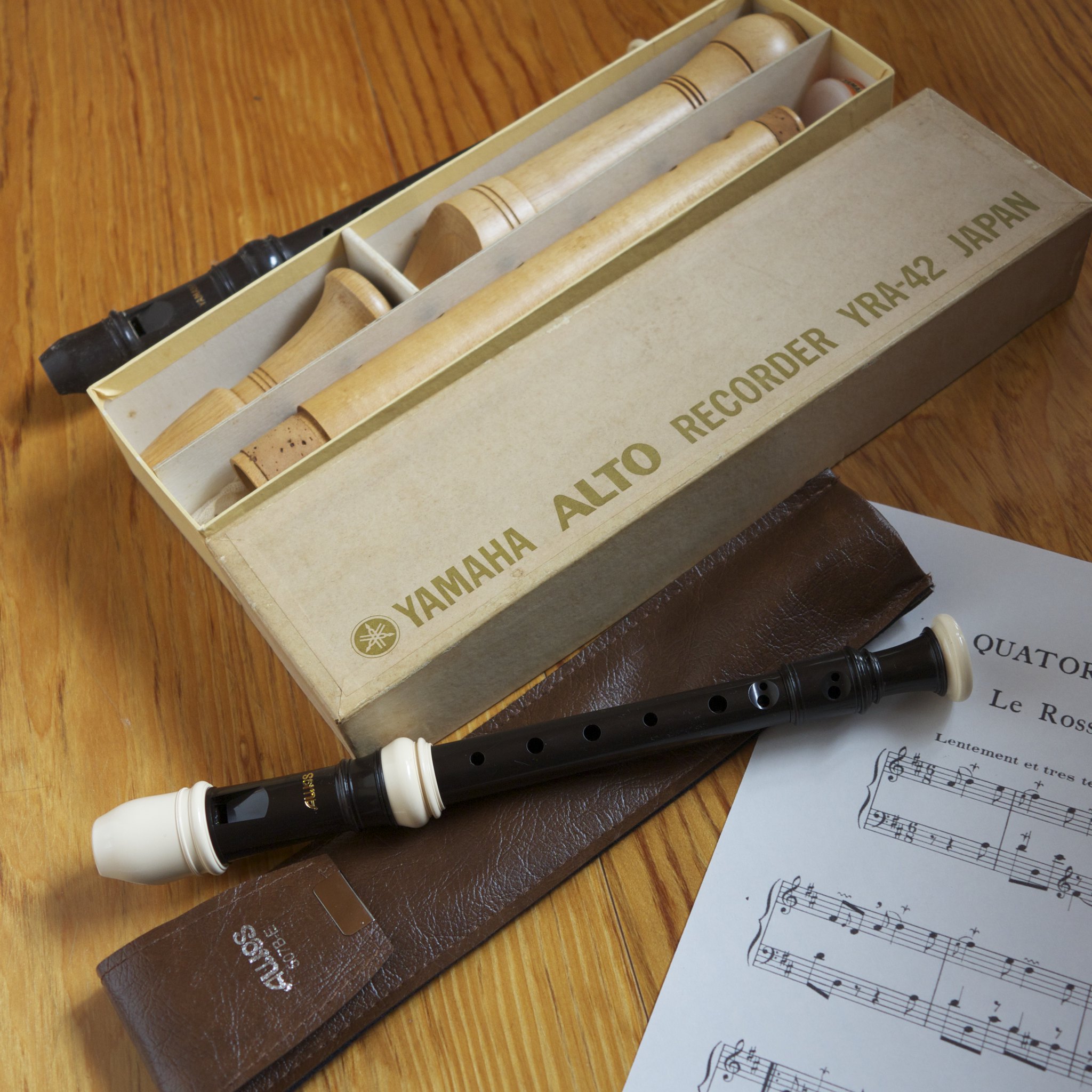The dizi, also known as the Chinese flute, is a six-holed, transverse flute. It might look similar to the word ‘dizzy’, but it’s actually pronounced like ‘deet-zuh’.
Dizi usually come in two pieces that attach together, much like how you’d put together a recorder. The Chinese flute comes in many keys, such a C, D, E , F, and G. Most professionals own a set (7 flutes). It’s a versatile instrument that is frequently used in Chinese opera, folk music and in orchestras.
Materials
The dizi is predominantly made out of bamboo. Violet, purple, and white bamboo are common choices. They can also be made from other woods, such as rosewood. Some Chinese flutes are even made of jade and other stones! (Though they are rumored to be more ornamental, as they are not very resonant).
Don’t get Dizzy: Here’s How to Play One
I recall opening up a Christmas package and seeing an ornately painted red and gold bamboo flute. What is it?! I remember asking excitedly. And, incorrectly assuming I could play most any flute, I picked up the dizi and immediately began to huff and puff. Oh, my corners hurt! And the sound that came out was weak and thin. How does this thing work?!
Here are a few tips on how to play this unique and challenging instrument:
- Use good posture
- Hold the flute parallel to the floor
- Place your mouth on the first hole ( which is located about a third of the way down the instrument)
- Lightly rest your fingers on the six holes
- Blow the air stream down towards the floor
Another unique thing about the dizi is it is actually a reversible instrument. You can play it either to the left or to the right. If you see a flute player holding their instrument to the left, don’t be surprised!
Dan Tang has a great instructional video for beginners!
In his video, he says that checking the membrane is the first step to playing the dizi; but of course! The membrane is what makes the flute work. This is one of the biggest mistakes I made when I first got my dizi- I was trying to play it without a membrane! So, if you don’t see a light covering over the second hole of your dizi, read on to figure out how to fix it.
Managing the Membrane
Another surprise I had when opening my dizi was that I found a tiny bag with a few trinkets in it. What are these things? I asked the person who had purchased it for me.
Chinese flutes often come with a traditional knot, dimo (packs of membranes) and glue. It may also come in a red, velvety carrying bag. The glue and membranes are the two most important things that come with your dizi.
The glue may appear to be a jar of green liquid, or a small rock. Either works just fine. They’re designed to be rubbed on the flute so that the membrane can stick. If your dizi doesn’t come with glue, you can actually use this temporary kitchen fix: Cut a raw clove of garlic, and rub it on the membrane hole until it is slightly moist. Then, carefully smooth the membrane on.
If the membrane is too tight or too loose, the sound your flute produces will be thin. In some cases, an incorrectly applied membrane may cause the flute to not sound at all! Membranes should have a few wrinkles when smoothed over. Fixing the dimo might sound like a difficult task, but we’ve scouted out a video to help you.
Fingerings
Once you’ve gotten the membrane attached and can produce a solid sound, it’s time to find a fingering chart. The dizi’s fingerings are based on the six-hole instrument (much like the C Western flute, recorder, saxophone, or the clarinet). The M in the fingering chart denotes where the embouchure hole is, and the D stands for the membrane. Fingering charts show open fingerings as white circles, closed as black circles, and half-hole fingerings as half-shaded circles.
Extended technique
The Chinese flute can perform many of the extended techniques that Western flutes can, such as flutter tonguing, multiphonics, trills, and slides. The Northern school of Chinese music tends to encourage more of these exploratory techniques, whereas the Southern school of Chinese music tends to be more peaceful and calm, often opting for slower tempos and more mild ornamentations.
Origins and Evolution

The Dizi comes from Han culture and is one of the most popular instruments in China. It has been around since 1st Century BC. It is currently used as a solo instrument, as well as in orchestras. It is also known as the hengdi or the di. To confuse us Western flutists even more, it is also called the hengchui! This was its original name, and it means "side-blown."
This flute became even more popular in China to accompany poetry, when the free-verse poem started becoming widespread. The most popular dizi is in D, which is also the key recommended for beginners. Dizis do come in other keys and sizes, though these are usually more difficult to play.
Traditionally, the dizi is made from just one piece of bamboo, but one piece isn’t very portable. The flute evolved in the 1920’s to come apart and have a copper attachment. You can listen to the sound of a modern one with William Arnold here: (Music begins at 2:45)
There are several different types of Dizi, including the bangdhi and the qudi. The Chinese flute is also referred to as just ‘bamboo flute’ as well, but be careful, because there are many types of eastern bamboo flutes.
Tuning
The Chinese flute did not always match equal temperament. Traditionally, the holes of the flute were equidistant. This led to the flute playing a series of whole tones and quarter notes.
In the 20th century, instrument makers created adjustments so that it could be made to play the major scale. However, traditional dizis are still used today in chinese opera, also known as Kunqu.
Dizi Flute Sheet Music
There is some sheet music targeted at those who want to enjoy traditional Chinese music! Here are a few options for some adventurous musicians who may not be ready to stamp their passport just yet!
Since the modern chinese flute does fit into our twelve tone scale, technically, any flute music that is in the key of your dizi could be played. And, if you get really skilled at this instrument, you can learn to note bend to play chromatic tones outside of your flute’s key.
Try this traditional Chinese song on your dizi if you have one! It is called Mo Li Hua, which means Jasmine Flower. It’s free thanks to flutetunes.com! And, if you’re a pianist, you’re in luck. There’s a book of Chinese Folk songs with the Jasmine Flower song here as well.
Buying A Dizi Flute
Chinese flutes tend to cost $30-$60 for a beginning model. However, like most instruments, the better they are, the more they cost. Nicoshine and OrientalMusicSanctuary are both well-known names. Nicoshine makes their flutes out of dried bitter bamboo. OrientalMusicSanctuary, however, makes their dizi’s from aged rosewood. If you’ve read our other articles, such as that on alto recorder or on piccolo, you know that rosewood is a high-quality material for instrument-making. Carrotmusic, Ammoon, Timiy, Dong Xue Hua, and Psycool are some names of other staple dizi manufacturers.
Chinese Flute Players
Ma Di is one of the most famous modern composers and performers for the Chinese flute. However, there have been many great players before him. Lu Chunling, for example, was a famous flute player who made his way up from working class to the Shanghai Conservatory of Music. He was originally a trishaw driver, but he turned his music into a full-time career. He is known for his composition Jinxi.
Yu Xunfa was a famous soloist from Shanghai, who earned a Lifetime Achievement Award from the People’s Republic of China. Xunfa was not only a dizi soloist; he was also a creator of the flute called the Koudi! Here’s his performance on the dizi, in the composition ‘Lake View on a Moonlit Autumn Night’.
Wrap-Up
The dizi flute is a beautiful and haunting instrument that is highly specialized! I hope this article has inspired you to learn more about traditional Chinese instruments, starting with purchasing some new music!






